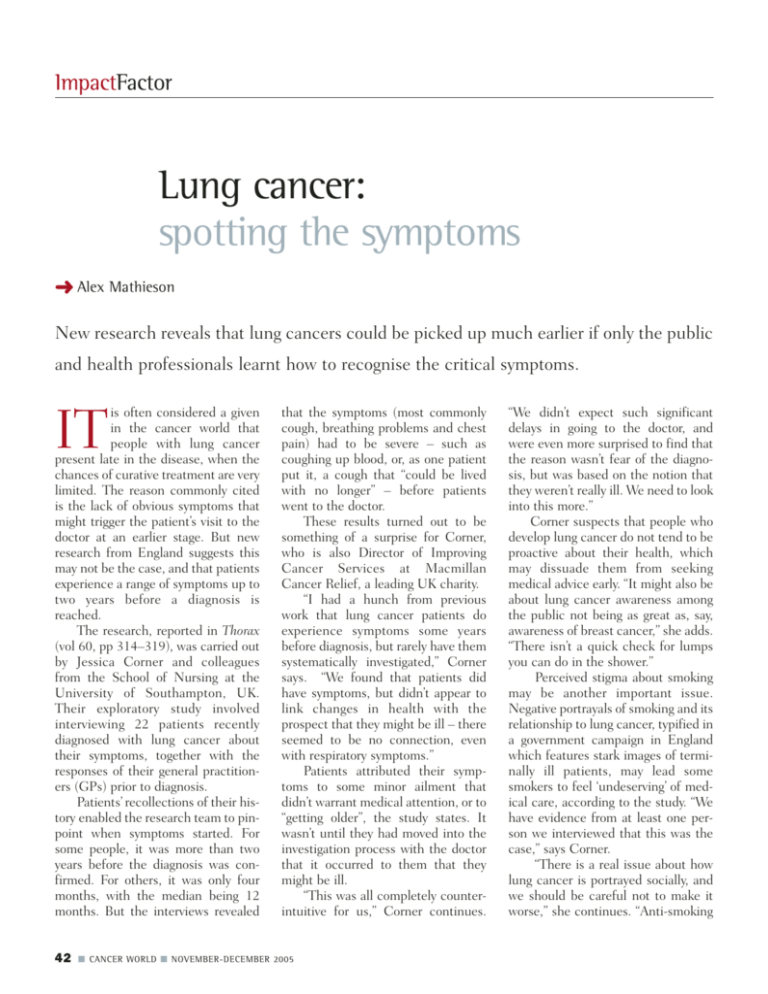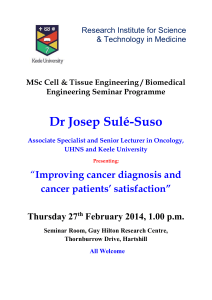Lung cancer: spotting the symptoms
advertisement

ImpactFactor Lung cancer: spotting the symptoms ➜ Alex Mathieson New research reveals that lung cancers could be picked up much earlier if only the public and health professionals learnt how to recognise the critical symptoms. IT is often considered a given in the cancer world that people with lung cancer present late in the disease, when the chances of curative treatment are very limited. The reason commonly cited is the lack of obvious symptoms that might trigger the patient’s visit to the doctor at an earlier stage. But new research from England suggests this may not be the case, and that patients experience a range of symptoms up to two years before a diagnosis is reached. The research, reported in Thorax (vol 60, pp 314–319), was carried out by Jessica Corner and colleagues from the School of Nursing at the University of Southampton, UK. Their exploratory study involved interviewing 22 patients recently diagnosed with lung cancer about their symptoms, together with the responses of their general practitioners (GPs) prior to diagnosis. Patients’ recollections of their history enabled the research team to pinpoint when symptoms started. For some people, it was more than two years before the diagnosis was confirmed. For others, it was only four months, with the median being 12 months. But the interviews revealed 42 that the symptoms (most commonly cough, breathing problems and chest pain) had to be severe – such as coughing up blood, or, as one patient put it, a cough that “could be lived with no longer” – before patients went to the doctor. These results turned out to be something of a surprise for Corner, who is also Director of Improving Cancer Services at Macmillan Cancer Relief, a leading UK charity. “I had a hunch from previous work that lung cancer patients do experience symptoms some years before diagnosis, but rarely have them systematically investigated,” Corner says. “We found that patients did have symptoms, but didn’t appear to link changes in health with the prospect that they might be ill – there seemed to be no connection, even with respiratory symptoms.” Patients attributed their symptoms to some minor ailment that didn’t warrant medical attention, or to “getting older”, the study states. It wasn’t until they had moved into the investigation process with the doctor that it occurred to them that they might be ill. “This was all completely counterintuitive for us,” Corner continues. ■ CANCER WORLD ■ NOVEMBER-DECEMBER 2005 “We didn’t expect such significant delays in going to the doctor, and were even more surprised to find that the reason wasn’t fear of the diagnosis, but was based on the notion that they weren’t really ill. We need to look into this more.” Corner suspects that people who develop lung cancer do not tend to be proactive about their health, which may dissuade them from seeking medical advice early. “It might also be about lung cancer awareness among the public not being as great as, say, awareness of breast cancer,” she adds. “There isn’t a quick check for lumps you can do in the shower.” Perceived stigma about smoking may be another important issue. Negative portrayals of smoking and its relationship to lung cancer, typified in a government campaign in England which features stark images of terminally ill patients, may lead some smokers to feel ‘undeserving’ of medical care, according to the study. “We have evidence from at least one person we interviewed that this was the case,” says Corner. “There is a real issue about how lung cancer is portrayed socially, and we should be careful not to make it worse,” she continues. “Anti-smoking ImpactFactor Jessica Corner: Anti-smoking messages are very important, but we must be careful not to deter people from coming forward for early diagnosis Jesme Baird: We must get the message across that every symptom requires a diagnosis – there’s no such thing as a ‘smoker’s cough’ messages are very important – there is no better thing to do than stop people smoking – but we must be careful not to do anything that might hamper people coming forward early for diagnosis.” Chest pain, for instance, typically has a very different presentation in lung cancer than it does in heart disease, but patients in Corner’s study who complained of chest pain were referred for heart checks. “Because they had pre-existing heart disease, it was assumed to be a cardiac problem,” she explains. “It wasn’t – it was lung cancer. You just feel that if the pain had been interrogated more thoroughly, it would have been quickly identified as non-cardiac.” Corner believes a similar situation applies with cough, the pattern of which is very different in lung cancer than it is in infections or asthma. The exploratory study was small and patient recollection has limitations as a research method, but Jesme Baird, Director of Patient Care at the INADEQUATE GUIDELINES Lung cancer awareness may also be lacking among the medical community, according to the study. GPs in England and Wales have been issued with referral guidance for suspected cancer from the National Institute for Health and Clinical Excellence (NICE), detailing signs and symptoms they might expect to see across a range of conditions. The guidelines, however, may not be sufficiently sensitive to allow doctors to identify symptoms that characterise lung cancer. Roy Castle Lung Cancer Foundation in the UK, feels the project raises some important questions that justify further study. “There is a real lack of research in the pre-diagnostic area,” Baird says. “We know that patients present late with lung cancer, but there hasn’t been any work looking at why this is the case. “The assumption has always been that the disease is very advanced by the time symptoms appear, but some of the patients in this study, even those with operable cancer, had symptoms for up to two years and thought nothing of them. If that attitude is more general, we have a big challenge on our hands in educating the public to report symptoms. “There may be lots of factors associated with patients’ delay in going to the doctor, and the study hasn’t been able to go into a lot of detail about them,” Baird continues. “But there are definitely big learning points about raising public awareness and getting messages across that every symptom requires a diagnosis – there’s no such thing as a ‘smoker’s cough’.” Corner’s team is now set to move onto bigger studies that can delve deeper into many of the issues raised by these latest research findings. They have already started work aimed at understanding more about patients’ behaviour, thoughts and feelings around symptoms, and projects to help GPs differentiate lung cancer symptoms from others are in the pipeline. “Patients did have symptoms, but didn’t appear to link them to the prospect that they might be ill” CANCER WORLD ■ NOVEMBER-DECEMBER 2005 ■ 43








